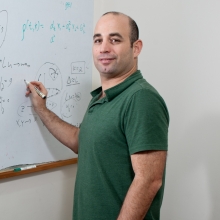Unveiling the architecture of proteins
Introducing Dr. Moran Shalev-Benami
New scientists

Proteins residing within our cells mediate every aspect of human physiology in health and disease. These proteins adopt complicated three-dimensional structures critical for their function. For Dr. Moran Shalev-Benami, the key to understanding how these miniature machines work is to find the right lens through which we can visualize their fascinating architecture — capturing these molecules in action.
A new hire in the Department of Structural Biology, Dr. Shalev-Benami uses electron microscopy to study the 3D structure of proteins: the complex molecules underlying the healthy function of the body’s organs and tissues. Her goal? To determine how the complicated architecture of these miniature machines enables them to perform their designated cellular tasks.
Dr. Shalev-Benami received her BA in molecular biochemistry from the Technion–Israel Institute of Technology and her MSc in biochemistry from the Hebrew University of Jerusalem. She returned to the Technion to complete her PhD in chemistry with a focus on structural biology. She became the first recipient of the Combined Weizmann-Abroad Postdoctoral Program for Advancing Women in Science, which finances female scientists performing a postdoctoral fellowship in Israel and abroad.
While working with Nobel laureate Prof. Ada Yonath, during her postdoctoral fellowship, Dr. Shalev-Benami used cryogenic electron microscopy (cryo-EM)—a state-of-the-art technology capable of visualizing biological molecules with near-atomic resolution—to visualize cellular targets residing within the parasitic protozoa Leishmania, a deadly pathogen afflicting millions around the globe. Atomic-level images obtained in this study revealed how anti-leishmanial drugs kill the parasite, and are helping the researchers identify hotspots in the parasitic cell that could be targeted by new therapies.
During her further postdoctoral studies at Stanford University and at the University of Michigan, Dr. Shalev-Benami developed her expertise in cryo-EM. Using this tool, she studied the structure of proteins responsible for regulating processes in the human central nervous system. This work has shed light on fascinating mechanisms that govern communication between brain cells.
“What I like most about cryo-EM is that it allows you to capture direct snapshots of molecules in action—snapshots that when put together, tell the story of how molecules work,” she says.
In her new lab at the Weizmann Institute, Dr. Shalev-Benami aims to investigate the structure of protein machineries that are expressed on cell surfaces, and which are in charge of cellular communication throughout the body. By combining cryo-EM with biochemistry, molecular biology, and mass spectroscopy techniques, she aims to inform the understanding of how these proteins work to maintain proper communication between cells, and how their malfunction contributes to the development of a variety of diseases and disorders. Importantly, her research will help to identify miscommunication hotspots for the development of novel, targeted therapeutics.
Dr. Moran Shalev-Benami is supported by the Harmstieg New Scientist Fund and The Pearl Welinsky Merlo Foundation.








